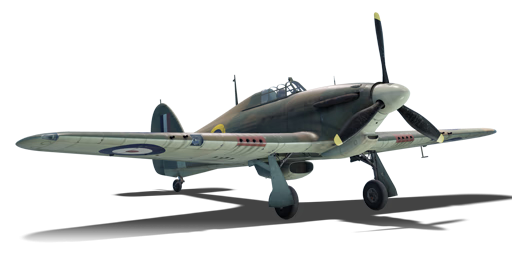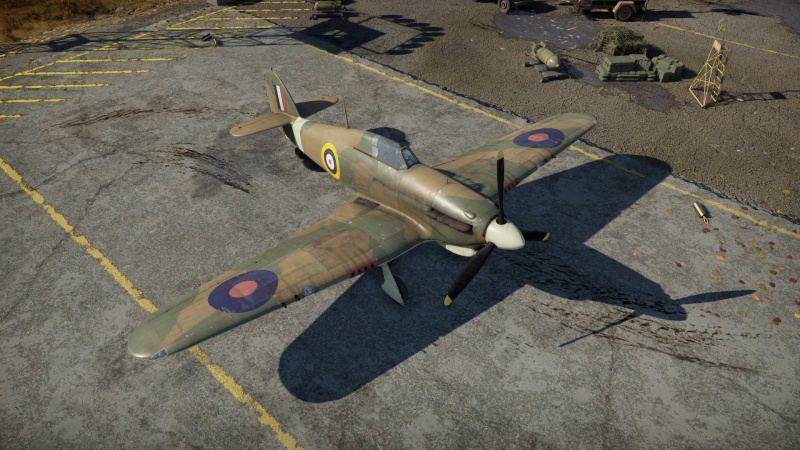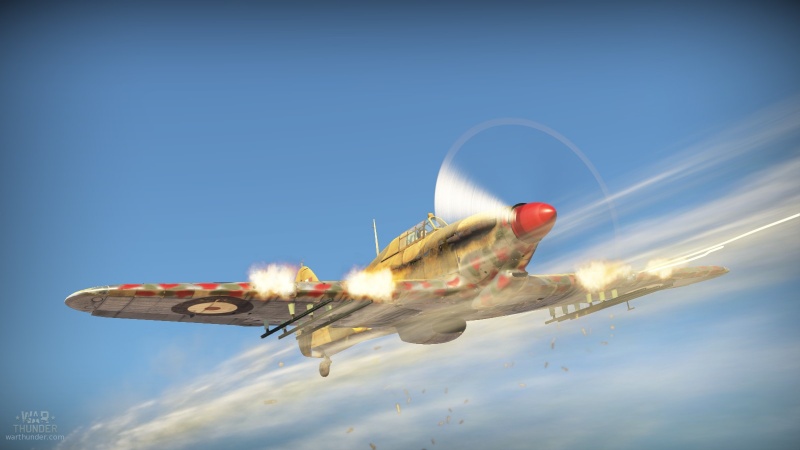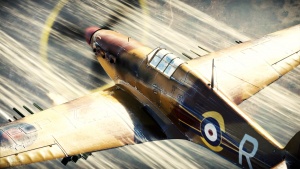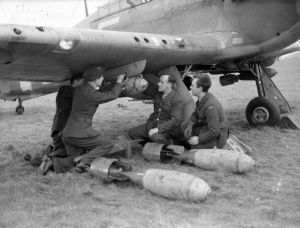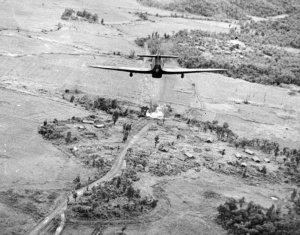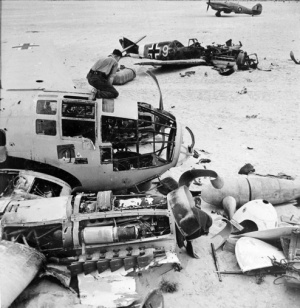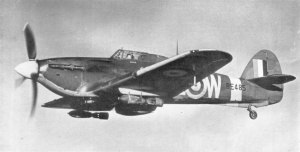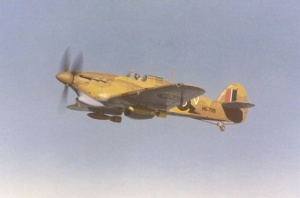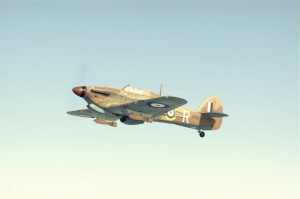Difference between revisions of "Hurricane Mk IIB/Trop"
(Tag: Visual edit) |
(Tag: Visual edit) |
||
| Line 195: | Line 195: | ||
* Is a stable gun platform with very smooth handling with simulator controls | * Is a stable gun platform with very smooth handling with simulator controls | ||
* Great in Ground Battles; rockets can easily penetrate lower-tier tanks, and is manoeuvrable enough to evade other fighters and SPAAs | * Great in Ground Battles; rockets can easily penetrate lower-tier tanks, and is manoeuvrable enough to evade other fighters and SPAAs | ||
| + | * In the hands of a capable and rather experienced pilot, it can be amazing in downtiers against biplanes | ||
'''Cons:''' | '''Cons:''' | ||
| Line 205: | Line 206: | ||
* Due to the Hurricane having a carburettor, inverted manoeuvres will cause the engine to fail due to fuel starvation. | * Due to the Hurricane having a carburettor, inverted manoeuvres will cause the engine to fail due to fuel starvation. | ||
* Ammo count may seem plentiful, but there are 12 guns that fire at the same time, so you technically only have 350 rounds; trigger discipline will be needed | * Ammo count may seem plentiful, but there are 12 guns that fire at the same time, so you technically only have 350 rounds; trigger discipline will be needed | ||
| + | * Default 7.7 mm gun rounds consist of ball rounds, which aren't sufficient penetrative bullets | ||
== History == | == History == | ||
Revision as of 00:25, 27 July 2024
| This page is about the British fighter Hurricane Mk IIB/Trop. For other versions, see Hurricane (Family). |
Contents
Description
The Hurricane Mk IIB/Trop is a tropicalized variant of the Hawker Hurricane Mk II. Compared to the Mark I version, the Mark II featured an addition of four 7.7 mm Browning machine guns in the outer leading edge of the wings along with bomb racks. The increase in number of small-calibre guns was due to the British still being reluctant to use the then notoriously jammable Hispano autocannons, and believing that adding more guns would compensate for lack of hard-hitting firepower that the Hispano could offer. While this only held true against lighter aircraft at closer range, the sheer number of guns and additional bomb racks allowed the Hurricane to find its new niche as a ground attacker during the Africa campaign, while leaving the air combat duties to the more nimble Spitfire instead.
The Hurricane Mk IIB/Trop has been in the game since the start of the Open Beta Test prior to Update 1.27. Compared to the early Hurricane models such as the Hurricane Mk I/L or the Sea Hurricane Mk IB, the Mk IIB/Trop is noticeably slower and less responsive than the Mk I version due to the addition of bomb racks and extra guns. While generally less agile, the Mk IIB can perform well enough as a fighter due to its agility. Though, like its predecessor, it is often held back by its slow top speed and acceleration.
Though the addition of bombs and rockets slowed down the plane somewhat, this allows the Mk II to perform as a close air support better than its predecessor. With twelve of 7.7 mm Browning MGs and absurd amount of ammo, the Hurricane is capable of obliterating any thin-skinned biplanes it may come across, having more than enough ammo to rake a huge number of ground target kills, and to give a good beating against more durable monoplanes in uptiers.
General info
Flight performance
The Hawker Hurricane IIB/Trop is very similar to the Hurricane Mk I/L in general flight characteristics, although the Hurricane Mk I/L performs a little better at everything except firepower and suspended armament. The Mk IIB/Trop is a little slower than the Mk I/L, and is fairly slow compared to the other fighters at the same BR. If you do get into a fight, use the Mk IIB's good manoeuvrability, and although it can take a fair amount of punishment, it is advisable not to just fly in in straight lines as you will present an easy target. If the aircraft becomes damaged try to hug the ground, using the terrain to your advantage to get back to your base to repair. However, if your engine is damaged (red or black), then do the exact opposite and gain as much altitude as you can, until your engine gives up and then work towards gliding to your base.
As a fighter, its flight characteristics and performance are sufficient for the fighter role within its rank. Although the Hurricane IIB's speed and more importantly turn time are considerably lower than the Spitfire and its other Hurricane relatives, it can stand its ground. It's forgiving and retains good turning characteristics at low speeds, though has a rather slow roll rate. With its forward centre of gravity, the Mk IIB is inclined to climb at full power. The plane is fairly easy to manoeuvre, and it often out-manoeuvres other planes at its level: even novice Japanese pilots can't quite escape a Hurricane that is under the control of a skilled pilot.
Furthermore, the Hurricane's heavy weight, due to its outdated box-girder structure, results in good vertical energy retention allowing the plane to engage in energy fighting. Boom & Zoom manoeuvres are possible, though the relatively low speed of the Hurricane makes this a risky business on longer stretches. Utilise them as a form of fighting in both Realistic and Simulator modes, as unlike in Arcade, regaining energy and speed after a turn fight takes some time, leaving you vulnerable to fighters that didn't join the furball. Keep in mind that the speed of the aircraft is not high and you can be easily caught by swifter enemies. If the player does press for turn-fighting keep your situational awareness up: you can turn on a penny, but once you get hit and damaged, controllability issues may leave you unable to avoid anything.
While it is agile against many other planes at its rank, it can easily be outclassed by planes above in an up-tier in terms of armament and agility. Overall, the Hurricane IIB is a rugged multipurpose aircraft and a joy to fly. If you want to know more about the ins and outs of flying the Hurricane, have a look at the historic pilot's notes. A great and forgiving fighter aircraft to fly for beginners and a deadly tool for those who know it well!
| Characteristics | Max Speed (km/h at 5,182 m) |
Max altitude (metres) |
Turn time (seconds) |
Rate of climb (metres/second) |
Take-off run (metres) | |||
|---|---|---|---|---|---|---|---|---|
| AB | RB | AB | RB | AB | RB | |||
| Stock | 487 | 471 | 11500 | 18.0 | 18.7 | 7.4 | 7.4 | 320 |
| Upgraded | 535 | 510 | 16.4 | 17.0 | 16.1 | 11.1 | ||
Details
| Features | ||||
|---|---|---|---|---|
| Combat flaps | Take-off flaps | Landing flaps | Air brakes | Arrestor gear |
| ✓ | ✓ | ✓ | X | X |
| Limits | ||||||
|---|---|---|---|---|---|---|
| Wings (km/h) | Gear (km/h) | Flaps (km/h) | Max Static G | |||
| Combat | Take-off | Landing | + | - | ||
| 660 | 320 | 268 | 246 | 202 | ~11 | ~6 |
| Optimal velocities (km/h) | |||
|---|---|---|---|
| Ailerons | Rudder | Elevators | Radiator |
| < 370 | < 250 | < 380 | > 410 |
Survivability and armour
- 6.35 mm Steel - Behind the engine
- 38 mm Bulletproof glass - Windscreen
- 12.7 mm Steel - Pilot's seat
The Hurricane's advantages don't come without its disadvantages, the biggest concern is its rather fragile engine and airframe. Its soft skin and light protection mean the Mark IIB can't take too much damage before it takes on critical damage. Once the aircraft is damaged, the plane often loses controllability, making survival far harder, as manoeuvrability is key for the British aircraft.
Modifications and economy
Armaments
Offensive armament
The Hurricane Mk IIB/Trop is armed with:
- 12 x 7.7 mm Browning machine guns, wing-mounted (350 rpg = 4,200 total)
With its twelve Browning machine guns, the Hurricane IIB is well suited for the fighter role as it packs a tremendous punch at this rank. The sheer number of guns compensates adequately for the lack of higher calibre armament. The number of guns comes at a price though: with 350 rounds per gun, ammunition can be expended rather quickly in RB and SB. Trigger discipline is key here and will benefit both ammunition conservation and fire accuracy. Nonetheless, the Hurricane is a very stable gun platform.
Suspended armament
The Hurricane Mk IIB/Trop can be outfitted with the following ordnance:
- Without load
- 2 x 250 lb G.P. Mk.IV bombs (500 lb total)
- 6 x RP-3 rockets
The aircraft can fulfil two roles once its suspended armament is unlocked and purchased. It either can take the role of a fighter or the role of a Hurri-bomber (nickname given to fighter-bomber variants). The fact that it can be equipped with either bombs or rockets allows the plane to play the role of ground attack or attack interceptor without missing a beat. When attacking ground units, the two GP Mk.IV 250lb bombs can quickly destroy targets such as tanks, pillboxes and certain ships. When it is equipped with six RP-3 rockets, it can become a very deadly plane against ground targets, but also bombers, heavy attackers and - with a bit of luck - other fighters.
Usage in battles
The twelve machine guns can be very deadly against planes at this rank, spewing what becomes a massive wall of lead toward enemy pilots, as long as the pilot gets into a fairly close range of their target (100 - 250 m is optimal) and firing at gun convergence. However, the twelve guns can burn through ammo fairly quickly, which can lead to constant reload in Arcade Battles and ammunition depletion in Realistic and Simulator Battles if the pilot doesn't manage his fire.
The Hurricane IIB is unique at its rank due to its ability to use either two 250 lb GP bombs, or six RP-3 rockets. This allows the pilot the choice between playing ground attack roles against heavy targets such as ships, pillboxes, and tanks, or in the spirit of the attacker role, intercepting larger planes such as heavy fighters or bombers and quickly putting them out of the fight. However, both weapons have a fairly long reload time (in AB).
When utilising the rockets in Arcade, the pilot must be able to carefully predict with great precision their enemy's movement. Leading their shots long enough to have the rocket make contact with any part of the plane; along with resisting the urge to spam all six at once only to miss or not be able to go after other planes. One rocket is sufficient against fighters and other small aircraft, but some bombers and larger planes can take up to two rockets directly and not be immediately put down. For RB & SB rocket armament is not advised for air to air fights. They slow the already sluggish Hurricane down even more. Against bombers, the main target of rockets in AB, crippling one engine will either result in devastating fires or will cause the plane to eventually crash on its long trip back to base. However, in ground-attack duties, they still excel and once fired, a great fighter aircraft with great dodge ability remains to fight on.
The Hawker Hurricane Mark IIB can be used in two roles with relative ease: as a fighter-bomber and a fighter. In the ground-attack fighter-bomber role, the aircraft packs a punch with both its primary and pylon armament. It can attack soft targets with its .303 Browning guns, though tougher, armoured targets cannot be destroyed with the primary armament. The rockets and bombs allow the player to crack these targets as well with relative ease. Experience will allow the player to deploy these weapons with accuracy and to great effect. As with the use of the primary armament to engage air targets, the use of ammo should be kept in mind when engaging ground targets as well. It's very easy to deplete the available rounds on a bothersome artillery emplacement only to find a bogey on your tail with no rounds left to engage.
As a fighter, the Hurricane Mk II stands its ground, though it is somewhat limited by its armament. It is not as nimble as its other relatives or the Spitfires. The latter has a turn-time of 15 seconds when fully upgraded, whereas the Mark IIB only manages a turn time of 23.7 seconds. This is something to keep in mind when fighting more manoeuvrable adversaries. The above mentioned limited amount of ammunition should also be considered when engaging as a fighter. The 350 rounds per gun can be spent in quick succession, so pay attention to the usage. Furthermore, the firepower of the guns is highest when engaging targets only in the gun convergence zone. Combining the two means that holding fire until finding a target at a suitable lead angle within the gun convergence zone results in a more accurate, more deadly and more conservative fire. Not combining the two means unnecessarily spending limited ammunition, losing accuracy and lacking lethal power.
Specific enemies worth noting
Fighters
- Bf 109s & Fw 190s - Although the latter are not commonly encountered at its BR, both the 109 and the 190 pose a large threat due to the tremendous firepower and boom-and-zoom characteristics. Whilst German pilots that allow themselves to lured into turn-fighting can be quickly destroyed, the boom-and-zoom tactics are harder to counter. The Hurricane packs a punch but is easily defeated by cannon power in a head-on engagement. It's more advisable to evade a head-on attack and try to engage after a quick turn. The Mark IIB pilot should avoid boom and zoom attacks and try to lure the opponent into a turn to follow or a complete turn fight in order to get a gun solution on the target. The Hurricane IIB isn't fast enough nor has the high-altitude performance its German opponents have, so don't think about winning such a race in the long run.
- Bf 110 - Again, the most dangerous scenarios include head-on and boom-and-zoom attacks. The Bf 110 packs one of the biggest punches at its tier, so be prepared to aggressively evade its guns. It is rather slow in turning and is a big target though, so if you do get a lead angle within convergence range, the Bf 110 can be taken out quite easily.
- Chaikas & Ishaks - In general, the Russians have the advantage here. Being more manoeuvrable and having heavier firepower available, the I-153 and I-16 can be a tough nut to crack. Avoid turn fights with these aircraft. You have the advantage of speed, but only marginally so. Avoid getting too close, unless you are leading the target. Do not engage multiple Russian bogeys when lacking support by other teammates.
- American fighters - US fighters at this tier turn faster than the Hurricane Mk IIB. These opponents also often surpass your aircraft's capabilities in terms of maximum speed and firepower. Turnfighting is key here, but avoid prolonged dogfights with your nimbler American opponents, as they will outturn you in the end.
Bombers
For all bomber targets you may encounter the tactics are bound by two main considerations: lack of ammunition and vulnerability of the Hurricane IIB. Engaging targets with speed advantage and firing within the convergence zone allows you to really do damage. The Mark IIB is a great bomber hunter, though in the hands of a novice pilot this will likely mean many return trips to base to reload those guns. Get accurate and await a powerful shooting solution.
Manual Engine Control
| MEC elements | ||||||
|---|---|---|---|---|---|---|
| Mixer | Pitch | Radiator | Supercharger | Turbocharger | ||
| Oil | Water | Type | ||||
| Controllable | Controllable Not auto controlled |
Not controllable Not auto controlled |
Controllable Auto control available |
Combined | Controllable 2 gears |
Not controllable |
The plane is very forgiving when using Manual Engine Settings
Prop pitch: this can safely be set to 100% when climbing but when flying level you should reduce it to 90%. This will not only give the engine a bit of a rest and reduce the amount of heat generated but it will also give you a few km/h in speed.
Radiator: if set to 30-40% you can climb without burning overheating your engine (will get orange but not red) to about 3.5km. After that, you should cut back a bit on the throttle and let the engine cool down.
Supercharger: this should be switched at 3.5km (11,482 feet) altitude for optimal performance.
Pros and cons
Pros:
- Multirole: fighter and fighter-bomber roles can be fulfilled
- Quite manoeuvrable: suitable for turn fighting
- Decent vertical energy retention: suitable for limited Boom & Zoom tactics
- "Heavy" armament for an early WW2 fighter: 12 x .303 Browning machine guns
- Great ammo capacity
- Excellent over-the-nose visibility ensures easy tracking and leading in cockpit view
- Is a stable gun platform with very smooth handling with simulator controls
- Great in Ground Battles; rockets can easily penetrate lower-tier tanks, and is manoeuvrable enough to evade other fighters and SPAAs
- In the hands of a capable and rather experienced pilot, it can be amazing in downtiers against biplanes
Cons:
- Fragile: engine and frame (fabric coated tube frame) are prone to damage
- High rate of fire: high ammo consumption if not cautious
- Not as manoeuvrable or speedy as its siblings and the Spitfire
- Additional armament is limited: reload time is slow in arcade battles
- Convergence is key: additional guns are mounted further out on the wing, resulting in a high convergence and beyond or below the target - the distance may result in a lot of missed shots.
- Due to the Hurricane having a carburettor, inverted manoeuvres will cause the engine to fail due to fuel starvation.
- Ammo count may seem plentiful, but there are 12 guns that fire at the same time, so you technically only have 350 rounds; trigger discipline will be needed
- Default 7.7 mm gun rounds consist of ball rounds, which aren't sufficient penetrative bullets
History
The plain one. The dumpy one. The underappreciated sister of the glamorous Spitfire, its partner in the Battle of Britain. The plane that took, according to some sources, roughly 60 per cent of the accounted kills during that air campaign in World War II. The plane in which the only Victoria Cross for Fighter Command was won by Ft Lt. James Nicolson. The plane in which a foreigner, the Czech Sgt. Josef František gained the third most victories of all pilots during the Battle of Britain: he gained 17 victories. The history of the Hurricane is not only interesting as it tells us something about the plane, but it is also equally important as it tells us about the desperate struggle in which it took part.
The Hurricane thus has a long, but rather overshadowed history during the first years of the War. It served in all the theatres of World War II. In many variants, the workhorse fighter continued to serve until the end of the War - although its large-scale and frontline use effectively ended by 1943. It was a front line fighter, night fighter, intruder, the fighter-bomber, naval fighter, reconnaissance aircraft and also had various non-combat roles.
Although a highly successful and popular fighter, by 1940 the Hurricane Mk I was already showing itself to be inferior to enemy fighters such as the Messerschmitt 109. Experience from the Battle of Britain had also proved that the Hurricane's rifle-calibre 0.303 machine guns were inferior to larger calibre weapons being operated by enemy aircraft.
The Hurricane II was the result of further development of the earlier Mark I versions. Powered by an improved and supercharged twelve-cylinder Merlin XX engine, the Mark II entered service at the end of the summer of 1940 -at the height of the Battle of Britain. It was further modified by adding the 'universal wing' to allow the use of underwing stores such as bombs and rockets. Later the plane would be known as the Mark IIA Series 1. Hawker experimented with various armament configurations, leading to the Hurricane Mk. IIA Series 2 having either twelve .303 (7.7 mm) Browning Mk II machine guns, or four 20 mm Hispano Mk II cannons. Whilst the problem of rifle calibre bullets still existed with the .303 Brownings, the Hurricane's weight of fire had at least been increased as an interim measure whilst more powerful weapons were being refined.
This configuration and the new Merlin XX engine made the production of the ageing Hurricanes worthwhile, as Spitfire production continued to increase. The series 2 with 12 Brownings would later become designated as the Mark IIB in 1941. The 56 Squadron was the first RAF squadron to be equipped with the new Hurricane Mk IIB in February 1941, and by the summer of the same year, 20 squadrons were operating the new Hurricane.
The series 2 with four Hispano cannons would become the Mark IIC. A tropical version of the Mark II was developed for service in the North African theatre of operations alongside naval versions designated Sea Hurricane and cannon-armed versions, such as the Mark IID and Mark IV. The latter showed that as the war progressed, the fighter role was abandoned in favour of a more suitable attack role.
Whilst the Hurricane was no longer effectively employed in its original role as a fighter by the end of 1942, it would go on to serve in many other capacities until it was finally retired from the RAF in January 1947.
| Archive of the in-game description | |
|---|---|
|
Although a highly successful and popular fighter, by 1940 the Hurricane Mk I was already showing itself to be inferior to enemy fighters such as the Messerschmitt 109. Experience from the Battle of Britain had also proved that the Hurricane's rifle-calibre 0.303 machine guns were inferior to larger calibre weapons being operated by enemy aircraft. The Hurricane I was developed by adding the 1280 HP Rolls Royce Merlin XX engine and lengthening the fuselage slightly. This Hurricane Mk IIA was further modified by adding the 'universal wing' to allow the use of under wing stores such as bombs and rockets. When a further two 0.303 inch Browning machine guns were added to each wing, the Hurricane was transformed into the Mk IIb. Whilst the problem of rifle calibre bullets still existed, the Hurricane's weight of fire had at least been increased as an interim measure whilst more powerful weapons were being refined. 56 Squadron were the first RAF squadron to be equipped with the new Hurricane Mk IIB in February 1941, and by the summer of the same year, 20 squadrons were operating the new Hurricane. The Hurricane Mk II would see further developments in the form of the Mk IIC, armed with four 20 mm Hispano cannon, and the Mk IID which was equipped with two 40 mm cannon in under wing pods for anti-tank duties. Whilst the Hurricane was no longer effectively employed in its original role as a fighter by the end of 1942, it would go on to serve in many other capacities until it was finally retired from the RAF in January 1947. | |
Media
- Skins
- Videos
See also
Links to the articles on the War Thunder Wiki that you think will be useful for the reader, for example:
- reference to the series of the aircraft;
- links to approximate analogues of other nations and research trees.
External links
Paste links to sources and external resources, such as:
- topic on the official game forum;
- other literature.
| Hawker Aircraft Limited | |
|---|---|
| Biplane fighters | |
| Fury | Fury Mk I · Fury Mk II |
| Nimrod | Nimrod Mk I · Nimrod Mk II |
| Scout plane | Osprey Mk IV |
| Piston fighters | |
| Hurricane | Hurricane Mk I/L · Hurricane Mk.I/L FAA M · Sea Hurricane Mk IB · Sea Hurricane Mk IC · Hurricane Mk IIB/Trop · Hurricane Mk IV |
| Typhoon | Typhoon Mk Ia · Typhoon Mk Ib · Typhoon Mk Ib/L |
| Tempest | Tempest Mk V · Tempest Mk V (Vickers P) · Tempest Mk II |
| Fury | Sea Fury FB 11 |
| Jet fighters | |
| Hunter | Hunter F.1 · Hunter F.6 · Hunter FGA.9 |
| Sea Hawk | Sea Hawk FGA.6 |
| Harrier | Harrier GR.1 · Harrier GR.3 |
| Export | ▄Hurricane Mk I/L · ▂Hurricane Mk IIB · ◘Sea Fury FB 51 |
| ◘Sea Hawk Mk.50 · ◄Sea Hawk Mk.100 · ◘Hunter F.6 · ◌Hunter F.58 · J34 · AV-8A · AV-8C · ▄AV-8S | |
| Captured | ▀Tempest Mk V |
| See Also | Fokker |


